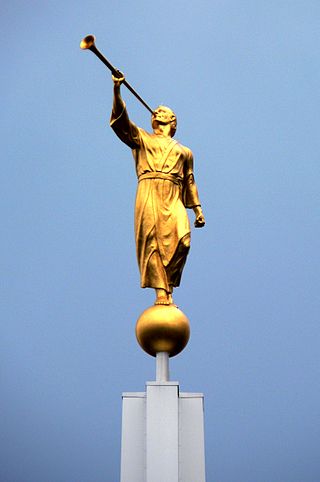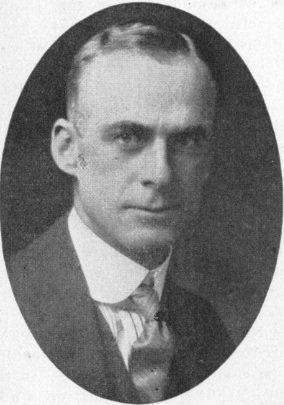
Brigham Young was an American religious leader and politician. He was the second president of the Church of Jesus Christ of Latter-day Saints from 1847 until his death in 1877. He also served as the first governor of the Utah Territory from 1851 until his resignation in 1858.

The angel Moroni is an angel whom Joseph Smith, founder of the Latter Day Saint movement, reported as having visited him on numerous occasions, beginning on September 21, 1823. According to Smith, the angel Moroni was the guardian of the golden plates buried near his home in western New York, which Latter Day Saints believe were the source of the Book of Mormon. An important figure in the theology of the Latter Day Saint movement, Moroni is featured prominently in its architecture and art. Besides Smith, the Three Witnesses and several other witnesses also reported that they saw Moroni in visions in 1829.
The Second Book of Nephi, usually referred to as Second Nephi or 2 Nephi, is the second book of the Book of Mormon, the primary religious text of the Latter-day Saint Movement. Narrated by Nephi, son of Lehi, unlike the first Book of Nephi, 2 Nephi contains little history of the Nephite people and focuses predominately on visions and prophecies of Nephi himself and other prophets, particularly Isaiah.

Deseret is a term derived from the Book of Mormon, a scripture of the Church of Jesus Christ of Latter-day Saints and other Latter Day Saint groups. According to the Book of Mormon, "deseret" meant "honeybee" in the language of the Jaredites, a group in the Book of Mormon that were led by God to the Americas after the construction of the Tower of Babel. Latter-day Saint scholar Hugh Nibley suggested an etymology by associating the word "Deseret" with the ancient Egyptian deshret, a term he translated as the "bee crown" of the Lower Kingdom, but which non-LDS scholarly sources translate as the "Red Crown".
In Mormonism, the restoration refers to a return of the authentic priesthood power, spiritual gifts, ordinances, living prophets and revelation of the primitive Church of Christ after a long period of apostasy. While in some contexts the term may also refer to the early history of Mormonism, in other contexts the term is used in a way to include the time that has elapsed from the church's earliest beginnings until the present day. Especially in the Church of Jesus Christ of Latter-day Saints "the restoration" is often used also as a term to encompass the corpus of religious messages from its general leaders down to the present.

According to most adherents of the Latter Day Saint movement, the Book of Mormon is a 19th-century translation of a record of ancient inhabitants of the American continent, which was written in a script which the book refers to as "reformed Egyptian". Mainstream modern linguistic evidence has failed to find any evidence of a language matching this description – or indeed, any evidence of Old World linguistic influences in the New World whatsoever.
The September Six were six members of the Church of Jesus Christ of Latter-day Saints who were excommunicated or disfellowshipped by the church in September 1993, allegedly for publishing scholarly work against or criticizing church doctrine or leadership. The term "September Six" was coined by The Salt Lake Tribune and was used in the media and subsequent discussion. The church's action was referred to by some as evidence of an anti-intellectual posture on the part of church leadership.

Hugh Winder Nibley was an American scholar and member of the Church of Jesus Christ of Latter-day Saints who was a professor at Brigham Young University (BYU) for nearly 50 years. He was a prolific author, and wrote apologetic works supporting the archaeological, linguistic, and historical claims of Joseph Smith. He was a member of the LDS Church, and wrote and lectured on LDS scripture and doctrinal topics, publishing many articles in the LDS Church magazines.

Charles Wilson Nibley was a Scottish-American religious leader, businessman, and politician. Nibley was a member of The Church of Jesus Christ of Latter-day Saints and served as the fifth presiding bishop of the Church of Jesus Christ of Latter-day Saints between 1907 and 1925 and a member of the church's First Presidency from 1925 until his death. He was also a businessman and was involved in various industries, such as lumber, sugar, and railroads.

The Pearl of Great Price is part of the canonical Standard Works of the Church of Jesus Christ of Latter-day Saints and some other Latter Day Saint denominations. It began as a pamphlet of documents published by Franklin D. Richards in Liverpool, England in 1851. It was later revised and canonized in 1880 by the Church of Jesus Christ of Latter-day Saints.

View of the Hebrews is an 1823 book written by Ethan Smith, a Congregationalist minister in Vermont, who argued that Native Americans were descended from the Ten Lost Tribes of Israel, a relatively common view during the early nineteenth century. Numerous commentators on Mormon history, from LDS Church general authority B. H. Roberts to Fawn M. Brodie, biographer of Joseph Smith, have noted similarities in the content of View of the Hebrews and the Book of Mormon, which was first published in 1830, seven years after Ethan Smith's book.

Studies of the Book of Mormon is a collection of essays written at the beginning of the 20th century by B. H. Roberts (1857–1933), a general authority of the Church of Jesus Christ of Latter-day Saints, which examine the validity of the Book of Mormon as a translation of an ancient American source.

Royal Jon Skousen is an American linguist and retired professor of linguistics and English at Brigham Young University (BYU), where he is editor of the Book of Mormon Critical Text Project. He is "the leading expert on the textual history of the Book of Mormon" and the founder of the analogical modeling approach to language modeling.

Alexander Neibaur was the first dentist to practice in Utah and the first Jew to join the Latter Day Saint movement. He was educated for the profession at the University of Berlin and was a skilled dentist before the establishment of dental schools in America. He was fluent in 7 languages and as many dialects.
Bookcraft was a major publisher of books and products for members of the Church of Jesus Christ of Latter-day Saints.

Preston Nibley was an American religious leader in the Church of Jesus Christ of Latter-day Saints, and wrote several books on the church, including several pieces of devotional literature.

Subjects of criticism of the Book of Mormon include its origins, authenticity, and historicity, which have been subject to considerable criticism from scholars and skeptics since it was first published in 1830. The Book of Mormon is a sacred text of the Latter Day Saint movement, which adherents believe contains writings of ancient prophets who lived on the American continent from approximately 2200 BC to AD 421. It was first published in March 1830 by Joseph Smith as The Book of Mormon: An Account Written by the Hand of Mormon upon Plates Taken from the Plates of Nephi, who said that it had been written in otherwise unknown characters referred to as "reformed Egyptian" engraved on golden plates. Contemporary followers of the Latter Day Saint movement typically regard the text primarily as scripture, but also as a historical record of God's dealings with the ancient inhabitants of the Americas.

The White Horse Prophecy is the popular name of an influential but disputed version of a statement on the future of the Latter Day Saints and the United States. It was given by Edwin Rushton in about 1900, and supposedly made in 1843 by Joseph Smith, Jr., the founder of the Latter Day Saint movement.
This is a bibliography of works on the Latter Day Saint movement.












